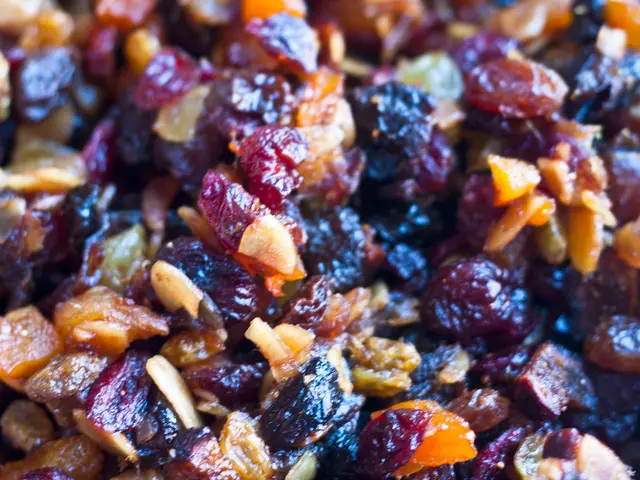Preserving Autumn's Bounty: Canning Apples
Preserving Apples through Canning: instruction on canning apple slices
Indulge in the crisp, delectable flavors of apples all year long by preserving them—the easy way. Canned apples offer a versatile, stored fruit that you can use to whip up your favorite apple dishes in a flash.
Savor the Salivation-Worthy Tastes of Canned Apple Slices
Instead of laboring over canned apple pie filling, apple butter, or apple crisp from scratch, why not can the apples and save yourself the trouble? Transform the canned fruit into your favorite goods whenever you feel the need.
Fruitful Choices for Canning Apples
While any variety of apple can find its way into a canning jar, some options work better than others. Opt for crisp apples that retain their shape well during cooking, such as Granny Smith, Pink Lady, Gala, Fuji, or Honeycrisp. These sturdy choices fare particularly well for canning and will remain delightfully crisp.
By all means, steer clear of softer varieties like Red Delicious, Jonathan, or Golden Delicious for canning; save these for snacking or turning into applesauce. Multipurpose apples like Cortland are usable for canning, albeit they won’t retain their crispness as effectively as cooking types.
Experiment with blending sweet and tart varieties to create an unforgettable finished product. Feel free to mix and match with your favorites to avoid using just one type of apple. Remember, the fresher the apple, the better the chances of a stellar canned product!
You’ll require approximately 2-3⁄4 pounds of apples per quart or 1-3⁄4 pounds per pint. For a full canner load, anticipate needing 19 pounds for a 7 quart load or 16 pounds for a 9 pint load, depending on apple slice size. A bushel of apples weighs 48 pounds and would yield roughly 16-18 quart jars or 26-28 pint jars.
Pro Tip: Mix up jar sizes to fit your needs. Quart and pint jars both undergo the same processing time.
Sprucing Up the Sweetness
Embrace the pleasure of customizing the sweetness of your canned apples. Although apples can be canned with water, a touch of sweetness through sugar, honey, maple syrup, or juice greatly enhances the flavor. Not only does the sweetener help preserve the apple’s taste, but it also brings out its full, mouthwatering potential.
Lightly Sweetened Options
- Very Light Syrup: This syrup option leaves the most natural flavor, minimally impacts the sugar content, and is the personal favorite for canning apples. A 7 quart load demands 10-1⁄2 cups of water with 1-1⁄4 cups of sugar. For a 9 pint load, 6-1⁄2 cups of water and 3⁄4 cups of sugar suffice.
- Light Syrup: This middle-of-the-road concentration boasts a respectable flavor balance and works well for a range of fruit canning recipes. A 7 quart load needs 9 cups of water and 2-1⁄4 cups of sugar, while a 9 pint load requires 5-3⁄4 cups of water and 1-1⁄2 cups of sugar.
A Wee Bit More Sugar
- Medium Syrup: This sweeter concoction results in a very tasty, high-sugar finished product. A 7 quart load requires 8-1⁄4 cups of water and 3-3⁄4 cups of sugar. A 9 pint load will require 5-1⁄4 cups of water and 2-1⁄4 cups of sugar.
Juicey Alternatives
Instead of water or syrup, commercially-obtained juice can be used. Apple juice is the optimal choice, of course, but white grape juice or pineapple juice are also effective substitutes.
Naturally Sweet Drizzles
Consider skipping the refined sugar and using honey or maple syrup instead. Substitute about 2⁄3rds honey or maple syrup in place of the sugar measurements in any syrup recipe mentioned above.
Applesauce All-Stars
Your apple peels and cores don't have to be discarded, tired cook! Instead, transform them into delectable, homemade apple cider vinegar.
Can-tastic Essentials
- A Water Bath Canner, Steam Canner, or Pressure Canner
- Pint or quart jars with two-piece lids
- Canning tools, including a jar lifter, bubble remover, funnel, and ladle
- Regular kitchen tools: a large mixing bowl, large stockpot, peeler, kitchen knife, cutting board, slotted spoon, and measuring cups
Canning Apples from Scratch
Apples can be canned using a water bath canner, steam canner, or pressure canner, depending on what best suits your preference. All canning methods are equally safe, so feel free to choose based on the convenience factor.
Apples necessitate peeling, coring, slicing, and hot packing before placing in hot jars. While it is possible to can raw apples, the resulting product is inferior in quality, so we’ll focus on hot-packed apples here. Keep in mind that liquid must be included to ensure an evenly heated canning process and to reduce bacterial load and minimize floating apples.
Step 1: Prepare Jars and Canner
Heat your jars, lids, and canner with water. Fill jars 2⁄3rds full of water and place them in the canner. Bring the entire ensemble to a 180°F simmer then maintain the temperature.
Step 2: Prepare Apples
In a large bowl filled with 2 quarts of water with 1⁄2 cup of lemon juice to prevent browning, prep the apple slices by peeling, coring, and slicing them. Add the prepared apples to the bowl; set aside.
Step 3: Make Syrup
Select the syrup syrup preferred and combine water and sugar (or honey/maple syrup) in a large pot. Heat the mixture until the sugar dissolves and bring to a boil.
Step 4: Heat the Apples
Once the syrup is boiling, reduce the heat and add the apple slices. Cook for 5 minutes to help banish air from the apples, thereby decreasing their propensity to float and absorb excessive liquid during processing.
Step 5: Pack Your Jars
Gently transfer each jar from its heated environment to a towel-lined counter, dump out the hot water, and pack the jars brimming with hot apples using a canning funnel and slotted spoon, leaving 1⁄2" of headspace.
Next, ladle hot syrup on top of the apples, maintaining 1⁄2" of headspace. Remove air bubbles and adjust headspace if necessary, then wipe the rim of the jar with a damp cloth, center the lid, and finger-tighten the screw band. Repeat for remaining jars.
Step 6: Time to Process Your Apples
Water Bath Canning: Ensure the jar tops are at least 1" submerged. Add the lid, bring the canner to a boil, and process quarts and pints for 20 minutes, adjusting for altitude.
Remove the lid from the canner, let the jars rest for 5 minutes, then transfer to a towel-lined counter.
Steam Canning: Cover the canner, turn on the heat, and steam until a steady steam escapes the vent hole. Process pints and quarts for 20 minutes, adjusting for altitude if necessary.
After steaming, remove the lid, let the jars rest for 5 minutes, and then transfer to a towel-lined counter.
Pressure Canning: Fill the canner with 2-3" of water, depending on the manufacturer's instructions. Put the lid on the canner and wait for a steady stream of steam to escape from the vent hole. Vent for 10 minutes.
Once the venting process is complete, put the weight on the canner (5 pounds for altitudes below 1,000 feet and 10 pounds for altitudes above 1,001 feet), allow the canner to come to pressure, and process pint jars and quart jars for 8 minutes.
Let the canner cool to 0 pressure naturally, then wait an additional 2 minutes before removing the lid. Carefully remove the lid and let the jars sit for an additional 10 minutes before removing to a towel-lined counter.
Let the jars sit undisturbed for 12 to 24 hours before verifying seals. Discard the screw bands, clean the jars, and store them in a cool, dark place.
Jars will remain fresh for a minimum of 18 months or as long as the seal is maintained.
What's Next?
Delight in the abundance of canned fruits:
- Canning Oranges: Water Bath Canned Orange Slices
- Canning Peaches: Easy Homemade Peaches for Your Pantry
- Canning Blackberries: Homemade Blackberries in Syrup
- For a sweet twist on canned apples, try adding spices such as cinnamon, nutmeg, or cloves to the syrup for a warm, comforting flavor.
- Don't forget that canned apples are excellent in various recipes, like pies, muffins, cobblers, and fruit compotes—making them a must-have in every home-and-garden lifestyle.
- To elevate the visual appeal of canned apples, consider adding a few slices of lemon or a cinnamon stick to each jar before sealing, ensuring a delightful aroma and presentation.








